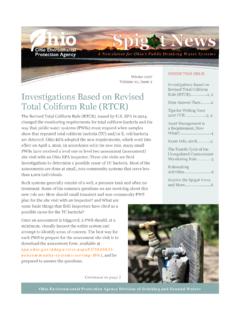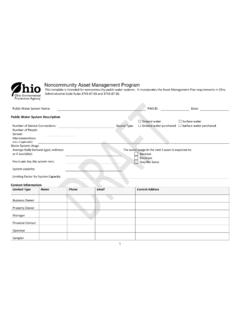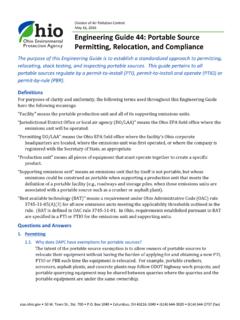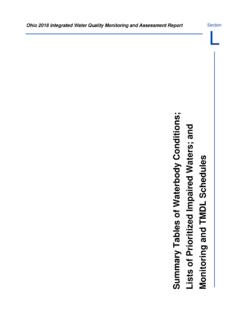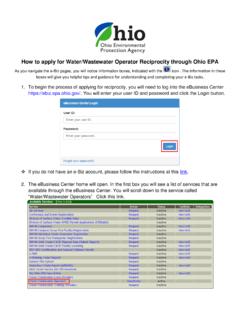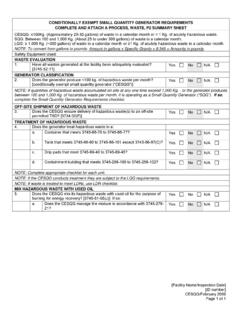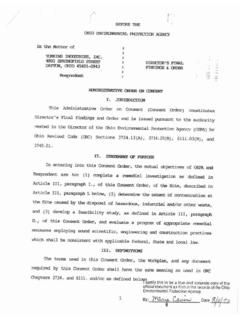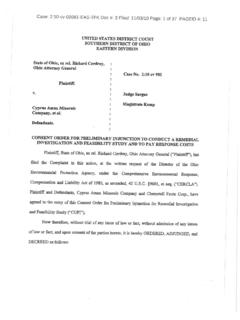Transcription of OBD Readiness - Ohio EPA
1 OBD Readiness One reason some vehicles cannot complete the E-Check is the on board diagnostic (OBD II) system Readiness monitors are not set. Frequently, this is caused by erasing the memory from the OBD system by either clearing any diagnostic trouble codes (DTC) or disconnecting the battery. If possible, when working on a vehicle that has failed the E-Check OBD II test due to an activated malfunction indicator lamp (MIL, check engine light), do not clear the DTC(s). If the cause of the original failure has been repaired properly, the DTC(s) will clear and the MIL will go out when the OBD system tests the repaired emissions control system.
2 If the DTC(s) have been cleared, there are various drive cycles to reset the monitors. Some monitors are continuously checked and take little driving to reset those. Some other monitors are checked intermittently and take more specific driving conditions to reset. Many vehicle manufacturers now include these drive cycles in the vehicle s owner s manual. Others will provide information in Technical Service Bulletins (TSB). Please note, some specific published drive cycles are intended to reset all monitors in the shortest amount of time as possible. In many cases, a few days of normal driving, both city and highway, will reset the monitors.
3 For general information regarding OBD II, including very specific drive cycles for Ford and GM (included in the following pages) vehicles (including which monitors are reset during specific driving events), see the following web site: More general information can be found at: . A generic drive cycle, which is identical to the GM drive cycle noted above, is included. In addition, some vehicle manufacturers provide information on how a vehicle owner can determine if the OBD system is ready for emissions checking by performing a certain procedure. Readiness Check The following paragraphs detail procedures on how to determine if the OBD II monitors are ready for E-Check.
4 For newer Ford/Lincoln/Mercury vehicles, to determine if the vehicle is ready for E-Check, turn the ignition key to the on position for 15 seconds without cranking the engine. If the service engine soon indicator blinks eight times, it means that the vehicle is not ready for E-Check; if the service engine soon indicator stays on solid, it means that the vehicle is ready for E-Check testing. This procedure was included in the Owner s Manual for a 2012 Ford Focus. This same procedure may apply to other models and model years Ford/Lincoln/Mercury vehicles. For Jeep, Chrysler and Dodge, the owner s manual states that the vehicle has a simple ignition key-actuated test, which you can use prior to going to the test station.
5 To check if your vehicle s OBD II system is ready, you must do the following: 1. Turn the ignition switch to the ON position, but do not crank or start the engine. If you crank or start the engine, you will have to start this test over. 2. As soon as you turn the ignition switch to the ON position, you will see the MIL symbol come on as part of a normal bulb check. 3. Approximately 15 seconds later, one of two things will happen: a. The MIL will flash for about 10 seconds and then return to being fully illuminated until you turn OFF the ignition or start the engine. This means that your vehicle s OBD II system is not ready and you should not proceed to the E-Check station.
6 B. The MIL will not flash at all and will remain fully illuminated until you turn OFF the ignition or start the engine. This means that your vehicle s OBD II system is ready and you can proceed to the E-Check station. Honda/Acura, from the owner s manual, to check if the Readiness codes are set, turn the ignition switch to the ON (II) position, without starting the engine. The MIL will come on for 20 seconds. If it then goes off, the Readiness monitors are set. If it blinks five times, the Readiness monitors are not set. Drive Cycles to reset OBD II monitors. The following paragraphs include information for manufacturer specific information regarding drive cycles.
7 If your vehicle make is not listed below, the following generic drive cycles are available: #gm_supp-reqs Some of these generic drive cycles are identical to the drive cycle included for GM vehicles (Chevy, Buick, Cadillac, GMC, Pontiac, Oldsmobile), which is included below. BMW: Drive Cycles are not included in the BMW public web site or owner s manual. The following drive cycle was found via an internet search: Chrysler/Dodge/Jeep: Drive Cycles are not included in the Chrysler/Dodge/Jeep public web site or owner s manual. The following drive cycle was found via an internet search: Generic drive cycle on Dodge forum: Ford: Newer Ford owner s manuals include a drive cycle, which is as follows: The OBD-II system is designed to check the emission control system during normal driving.
8 A complete check may take several days. If the vehicle is not ready for E-Check testing, the following driving cycle consisting of mixed city and highway driving should be performed: 15 minutes of steady driving on an expressway/highway followed by 20 minutes of stop-and-go driving with at least four 30-second idle periods. Allow the vehicle to sit for at least eight hours without starting the engine. Then, start the engine and complete the above driving cycle. The engine must warm up to its normal operating temperature. Once started, do not turn off the engine until the above driving cycle is complete.
9 If the vehicle is still not ready for E-Check testing, the above driving cycle will have to be repeated. GM (Chevy, Buick, Cadillac, GMC, Pontiac, Oldsmobile): Drive Cycles are not included in the manufacturer s public web site or owner s manual. The following drive cycle is from : To perform an OBDII Driving cycle, do the following: 1. Cold Start. In order to be classified as a cold start the engine coolant temperature must be below 122 F and within 11 F of the ambient air temperature at startup. Do not leave the key on prior to the cold start or the heated oxygen sensor diagnostic may not run. 2.
10 Idle. The engine must be run for two and a half minutes with the air conditioner on and rear defroster on. The more electrical load you can apply the better. This will test the O2 heater, passive air, purge "no flow", misfire and if closed loop is achieved, fuel trim. 3. Accelerate. Turn off the air conditioner and all the other loads and apply half throttle until 55mph is reached. During this time the misfire, fuel trim, and purge flow diagnostics will be performed. 4. Hold Steady Speed. Hold a steady speed of 55mph for 3 minutes. During this time the O2 response, air Intrusive, EGR, purge, misfire, and fuel trim diagnostics will be performed.
